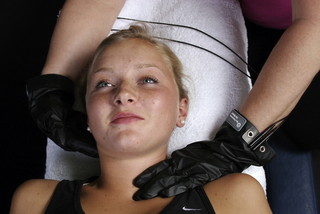7.16 Frequency-specific microcurrent Microcurrent electrical neuromuscular stimulation (MENS) was developed in the 1970s as a battery-operated physical therapy modality delivering current in the microampere range. An ampere (amp) is a measure of the strength of electric current and measures the rate of flow of charge in a conducting medium. One microamp (μA) equals 1/1000th of a milliamp (mA). By comparison, interferential, TENS, and high-volt pulsed galvanic stimulators deliver currents in the milliamp range causing muscle contraction, pulsing, and tingling sensations. TENS applies an electrical force that stimulates pain, suppressing A-beta afferent fibers which compete against A-delta and C fibers that transmit pain signals. Most TENS units deliver current around the 60 milliamp range (Kirsch & Lerner 1998). Although microcurrent devices are approved in the category of TENS for regulatory convenience, in practical use they are in no way similar and cannot be compared to TENS in their effect. Microcurrent is subsensory and cannot be felt by the patient (Mercola & Kirsch 1995). Traditionally, microcurrent therapy has been used to increase the rate of healing in injured athletes, to treat and manage muscle pain and dysfunction and increase the rate of fracture repair (Rowley et al. 1974; Bertolucci & Grey 1995; Kirsch 1996; Kirsch 1997; Lambert et al. 2002). Current in the range of 10 up to 500 microamps was observed to increase ATP production, amino acid transport, protein synthesis, and waste product removal in rat skin, whereas ATP production leveled off between 500 and 1000 microamps and decreased when the current was above 1000 microamps (Cheng et al. 1982). TENS devices provide up to 60 times higher current levels than those seen to decrease ATP production, which may explain why TENS units have not been found to be effective in treatment of myofascial pain. Typical microcurrent applications use only low and simple one-channel frequencies such as 0.3 Hz, 3 Hz, 10 Hz, 30 Hz, and 300 Hz (Manley 1994). The current protocols for the use of frequency-specific microcurrent (FSM) in treatment of myofascial pain, trigger points and fascia, as described in this chapter, have been developed over the past 15 years. These were originally based on the clinical recommendations of a previous generation of practitioners using these methods. Via a process of trial and error, it was determined, through clinical use on volunteers, that the use of frequency combinations that did not produce improvement also did no apparent harm. The descriptions of the frequencies, based on the recommendations mentioned, were initially taken at face value, and used speculatively for various chronic and acute conditions, to determine if they would produce a change in symptoms and clinical improvement (McMakin 1998; McMakin 2004; McMakin et al. 2005). A current of 40 Hz was initially recommended as being useful to ‘reduce inflammation.’ Use of this frequency in a clinical setting suggested that it did only that and was not useful to change any other condition, and it was found that no other frequency would reduce inflammation. Use of 40 Hz on channel A and 10 Hz on channel B was found to reduce pain in fibromyalgia patients from an average 7.4/10 to 1.4/10 VAS and to reduce all of the inflammatory cytokines as measured by micro-immunochromatography at logarithmic rates by factors of 10 to 20 times in 90 minutes. Medical cytokine researchers report that cytokines are difficult to modify, and change slowly when they can be made to do so. The control patient who had myofascial pain, but not fibromyalgia, was treated with a protocol for myofascial trigger points that did not include 40 Hz or 10 Hz and had no change in cytokines, although the myofascial trigger points and pain resolved (McMakin et al. 2005). One set of frequencies has been found to be so effective at removing or remodeling scar tissue that they were shown to be effective in treating mature burn scarring. Eight patients with long-term burn scarring were measured for range of motion on a Monday by occupational therapists in the burn unit at Mercy St. John’s Hospital in Springfield, Missouri. They were treated 1 hour per day for 3 days and range of motion was measured on Friday and weekly for 4 weeks following the treatment. Seven patients completed treatment and the eighth dropped out for reasons not involving the treatment. All patients had a statistically significant improvement in range of motion that persisted for the 4-week follow-up period. Clinical use in athletes and pain patients alike confirms this effect in softening and apparently eliminating scar tissue (Huckfeldt et al. 2003). However, the frequencies for fibrosis, scarring and hardening change only range of motion and tissue texture, and have no effect on inflammation or swelling. The outcomes were described as simple averages. The average chronicity was 4.7 years in head, neck and face pain, and after 11.2 treatments over a 7.9-week treatment period the average pain levels decreased from 6.8/10 to 1.5/10. There was no control group but the patients in some sense served as their own control since 88% (44/50) had failed with some other therapy. Seventy-five percent of patients (33/44) had failed with medical care, 54% (24/44) had failed with chiropractic, 38% (17/44) had failed with physical therapy, 11% (5/44) with naturopathic care, and 6% (3/44) with acupuncture. Many patients had used two or more of these therapies, with minimal to no permanent relief (Fig. 7.16.1). Fig. 7.16.1 • Treating the anterior cervical fascia.
History of frequency-specific microcurrent (FSM) therapy
FSM and inflammation
FSM and scar tissue
Clinical outcomes in the treatment of myofascial pain

The current and frequencies can be delivered by graphite gloves worn on the practitioner’s hands. The softening and elongation of the fascia in the anterior cervical muscles, especially the scalenes and longus coli, at the same time as the posterior muscles relax and soften, increases cervical range of motion, reduces pain and produces rapid improvement in chronic neck pain.![]()
Stay updated, free articles. Join our Telegram channel

Full access? Get Clinical Tree


Musculoskeletal Key
Fastest Musculoskeletal Insight Engine






